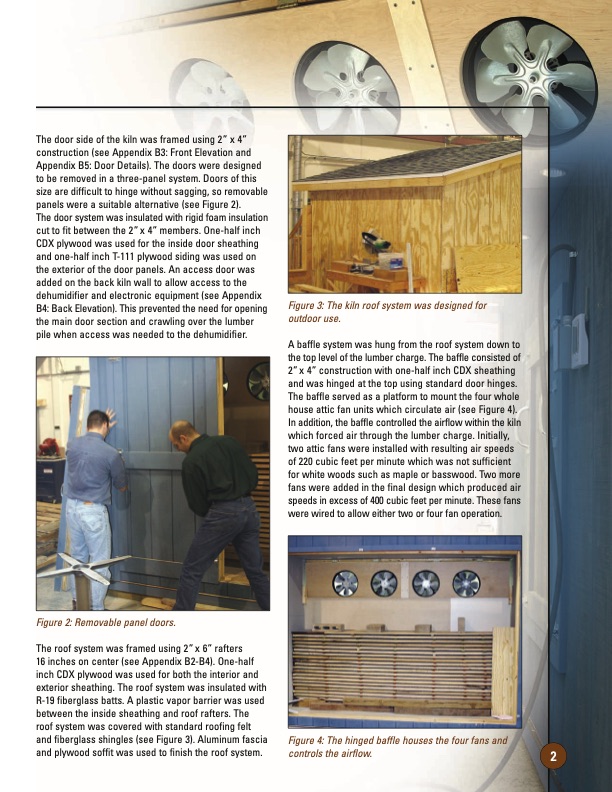
PDF Publication Title:
Text from PDF Page: 003
The door side of the kiln was framed using 2” x 4” construction (see Appendix B3: Front Elevation and Appendix B5: Door Details). The doors were designed to be removed in a three-panel system. Doors of this size are difficult to hinge without sagging, so removable panels were a suitable alternative (see Figure 2). The door system was insulated with rigid foam insulation cut to fit between the 2” x 4” members. One-half inch CDX plywood was used for the inside door sheathing and one-half inch T-111 plywood siding was used on the exterior of the door panels. An access door was added on the back kiln wall to allow access to the dehumidifier and electronic equipment (see Appendix B4: Back Elevation). This prevented the need for opening the main door section and crawling over the lumber pile when access was needed to the dehumidifier. Figure 2: Removable panel doors. The roof system was framed using 2” x 6” rafters 16 inches on center (see Appendix B2-B4). One-half inch CDX plywood was used for both the interior and exterior sheathing. The roof system was insulated with R-19 fiberglass batts. A plastic vapor barrier was used between the inside sheathing and roof rafters. The roof system was covered with standard roofing felt and fiberglass shingles (see Figure 3). Aluminum fascia and plywood soffit was used to finish the roof system. Figure 3: The kiln roof system was designed for outdoor use. A baffle system was hung from the roof system down to the top level of the lumber charge. The baffle consisted of 2” x 4” construction with one-half inch CDX sheathing and was hinged at the top using standard door hinges. The baffle served as a platform to mount the four whole house attic fan units which circulate air (see Figure 4). In addition, the baffle controlled the airflow within the kiln which forced air through the lumber charge. Initially, two attic fans were installed with resulting air speeds of 220 cubic feet per minute which was not sufficient for white woods such as maple or basswood. Two more fans were added in the final design which produced air speeds in excess of 400 cubic feet per minute. These fans were wired to allow either two or four fan operation. Figure 4: The hinged baffle houses the four fans and controls the airflow. 2PDF Image | DH Drying for Small Woodworking Firms and Hobbyists

PDF Search Title:
DH Drying for Small Woodworking Firms and HobbyistsOriginal File Name Searched:
dhkilns.pdfDIY PDF Search: Google It | Yahoo | Bing
5,000 BF Shipping Container Lumber Dry Kiln For Quality Lumber The 5,000 BF container kiln consists of one 40 foot high-cube aluminum shipping container... More Info
Shipping Container Lumber Dry Kilns by Global Energy Global Energy designed and developed the container kiln back in 1991. The purpose is to give access to portable sawmill owners, furniture makers, and small business the value added profit of dry kiln lumber and quality hardwoods... More Info
Vacuum Kiln Conversion Kit for Lumber and Wood Dry Kilns Convert your existing conventional dry kiln into a fast drying vacuum kiln. Similar to vacuum bagging in the boat building and aircraft industry, we have come up with a proprietary process which allows you to build a very simple vacuum kiln at a fraction of the price, and without the intensive conventional metal chamber structure... More Info
Vacuum Pump Cart System for Bagging Clamping Wood Drying and more Vacuum Cart with 2HP Pump and Dual Pistons with multiple multiplex vacuum ports and liquid reservoir... More Info
Vacuum Bagging Basics Vacuum bagging is a method of clamping, which has traditionally been used in the composites industry, but can also be used for vacuum drying materials, including wood products... More Info
| CONTACT TEL: 608-238-6001 Email: greg@globalmicroturbine.com | RSS | AMP |